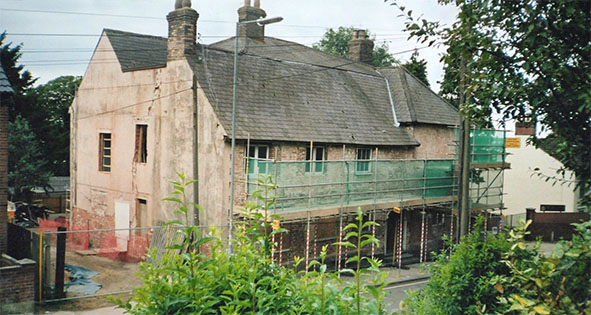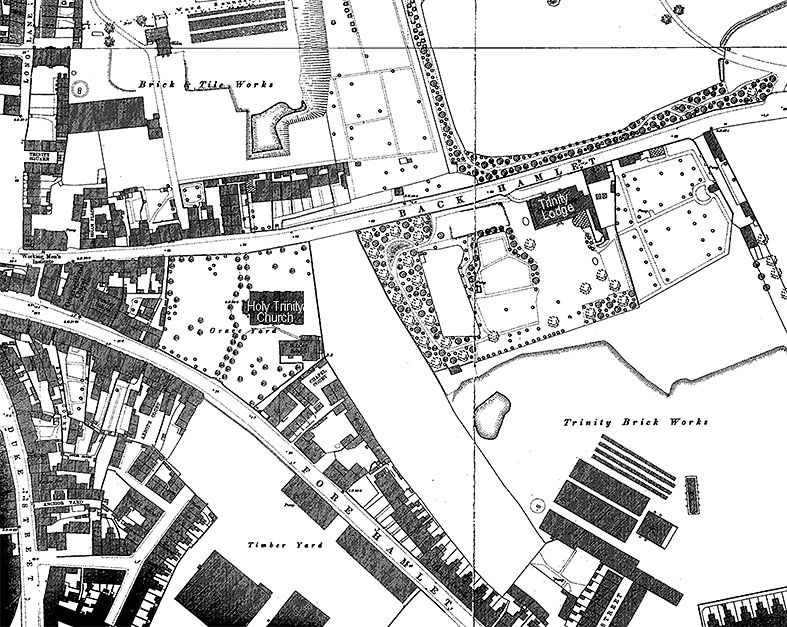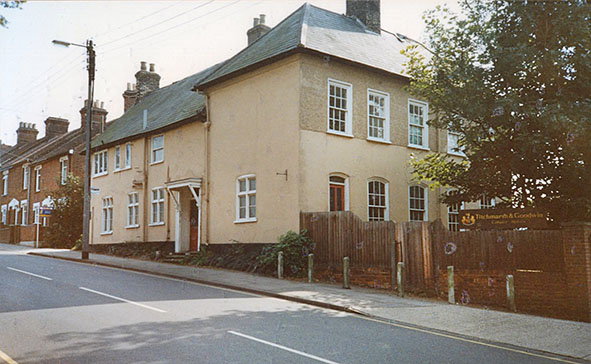- Screen Colours:
- Normal
- Black & Yellow

Trinity Lodge during renovations c.2003
Standing half-way up Back Hamlet, Trinity Lodge commanded splendid views over the river and countryside beyond. It has been suggested that it was built as a farmhouse in the 16thcentury. The once thatched roof remained hidden under Victorian slates for decades until major renovation work was undertaken in 2003. An 1881 Ordinance Survey map depicts a substantial garden and orchard. We know that Trinity Brick Works adjoined Fore Hamlet when the map was drawn and, lower down the hill on the other side of Back Hamlet, was another brick and tile works; plus the Old Pottery which was to become the site of Ipswich Civic College in the 1960s.
In his book Rags and Bones, Frank Grace states that some important townsmen lived in elevated positions such as Bishops Hill and Back Hamlet, away from the densely populated town. One would expect the vicar of nearby Holy Trinity Church to live close by at Trinity Lodge. Instead, it was home for the vicar of St Lawrence, whilst Rev. Francis Maude, the vicar of Holy Trinity Church, lived in an equally elevated home on Bishops Hill.
O.S. map detail 1881

In 1924 furniture manufacturers Gordon Goodwin and Frederick Titchmarsh purchased a builder’s yard from Alfred Gayford situated in the one-time garden of Trinity Lodge. Later they bought a terraced house, 106 Back Hamlet for office accommodation, then in 1948 the ‘Mansion House’ or ‘Trinity Lodge’ was purchased for £2,370, together with a parcel of adjoining land thereby providing wider access to their premises.
During the hot summer of 1963, fire destroyed their workshops and the following year I joined Eric Lait at the drawing board in their new building. Eric had worked for the firm since 1936 and aside from a spell in the RAF during World War II this was his only job. Whilst working together he told me about his early years with the firm, various former employees, special commissions, etc. He was then living in Back Hamlet and spoke of the night of the fire when he, together with Jeremy Goodwin and his wife, rescued drawings from the burning buildings, these rolls of full-size drawings were then stored in the attic of the Lodge which Eric didn’t favour visiting. Apparently a colony of rats also lived there!
In the early sixties, the ground floor of the Lodge was let out to tenants; one of Gordon’s sons with his family in one part which included a fully panelled room and Gordon’s secretary and her husband in another which was later let to one of the cabinet-makers. My first impression on entry to the hall, with its decoratively tiled floor and curved balustrade, was of a rather fusty smell.
When the tenants moved on, Trinity Lodge sadly waited for care and attention. On occasions Jeremy Goodwin would ask me to come up with some ideas for converting the building into a number of self-contained flats; another time, my brief was to consider four independent dwellings but nothing ever became of them.
In the seventies business was booming, men were on overtime and the new workshops were spilling over with furniture. Some pieces were briefly stored in the Lodge and sometimes a polisher worked there to give more room in the polishing shop.
Since his early days, Eric had taken black and white photographs of all new items and in the seventies he began to use a large room in the Lodge as a studio. He took a polaroid first, then using a wooden plate camera fired two shots at varying apertures before processing them in the darkroom. Just prior to Eric’s retirement in 1986, Mike Atkins came on board and from then onwards all shots were in colour, the negatives being sent to Colchester for processing.
Often I set up the shots, decorating with props, considering the preferred angle to give the best image. Unlike many professional photographers we had no screens, or rolls of coloured paper, no fancy lighting. However, there was a selection of wallpapers which I stuck on the wall with Blu- tack for a quick change of background, also odd lengths of fabric suggested window drapes. On one occasion a professional photographer, accustomed to shooting the homes of celebs etc. for glossy magazines, was commissioned to produce a range of photographs for a new brochure. He used 35mm film and took dozens of each scene as he said the film was cheap.
Clients came from all over the world: princes, presidents and kings. I often wondered what some of them would think of us working as we did on a shoestring, capturing their splendid and costly commissions on Kodachrome. (Example photograph on the Editorial page.)

The Lodge with the T&G entrance to the right.
Trinity Lodge was sold in 2002 ending the in-house photography. Ipswich Building Preservation Trust had contemplated renovating the sadly decaying building but such thoughts came to nothing and in 2003 a property developer stepped in to transform Trinity Lodge into two adjoining houses.
Heather Staff
See also the story of Titchmarsh & Goodwin, From mighty oaks . . . came Gordon Goodwin’s dream in the May 2020 issue.